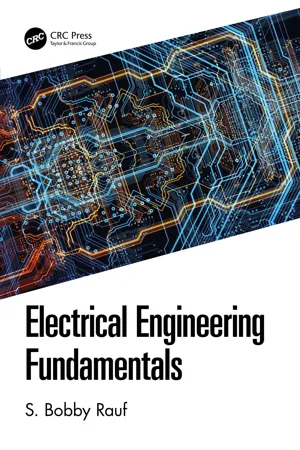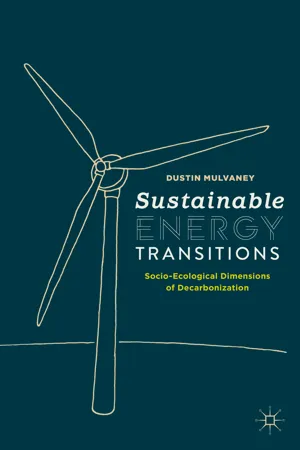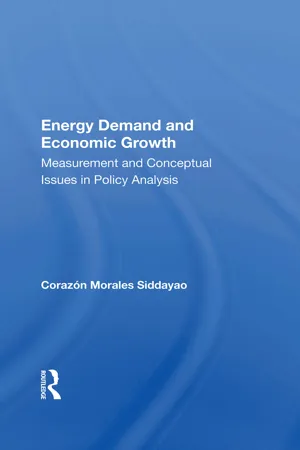Physics
Power and Efficiency
Power is the rate at which work is done or energy is transferred, measured in watts. Efficiency is a measure of how well a device or system converts input energy into useful output energy. It is calculated by dividing the useful output energy by the total input energy and is often expressed as a percentage.
Written by Perlego with AI-assistance
Related key terms
Related key terms
1 of 4
Related key terms
1 of 3
5 Key excerpts on "Power and Efficiency"
- eBook - ePub
- S. Bobby Rauf(Author)
- 2020(Publication Date)
- CRC Press(Publisher)
4 DC and AC Power, Efficiency, and Energy FlowIntroduction
In this chapter, we begin with an introduction to concepts of power, energy, and efficiency. Direct current (DC) Power and Efficiency discussion sets the stage for the more complex concepts of single-phase alternating current (AC) power and AC energy. And, discussion of single-phase AC serves as a suitable segue for consideration of the more complex subject of three-phase AC power. Significance of efficiency and energy will be explained within the context of DC and AC powers. Once the basic understanding of AC and DC powers is clear, we will be better poised to examine the flow of power and energy from the point of generation to the point of consumption. The flow of power and energy from some common sources such as steam and water to electricity is described, with illustrations in the form of example problems and self-assessment problems. The flow of power from utility to pumps is discussed in the “Wire to Water” section. Conversely, the flow of power and energy from water to wire and steam to wire is illustrated through hydroelectric and steam turbines, respectively.Power
Power can be defined in multiple ways. Power can be defined as the rate of performance of work, rate of generation of energy, rate of consumption of energy, and even as rate of application of torque. This is congruent with the fact that work, energy, and torque are equivalent with respect to the magnitude. All three can be quantified or measured – in the Metric or SI system – as N-m (Newton-meters) or J (Joules). In the US unit realm, work, energy, and torque can be measured in ft-lbf, in-lbf, BTU (British Thermal Unit), Hp-hr (horsepower-hour), etc. Since power is a derivative of energy with respect to time, its units in the SI or Metric realm are N-m/s (Newton- meters/second) or J/s (Joules/second). And, the units for power in the US domain are ft-lbf/s (foot-pound force/second), in-lbf/s (in-pound force/second), BTU/s (British Thermal Units/second), and hp (horsepower). - eBook - ePub
Sustainable Energy Transitions
Socio-Ecological Dimensions of Decarbonization
- Dustin Mulvaney(Author)
- 2020(Publication Date)
- Palgrave Macmillan(Publisher)
Throughout this chapter, there are example problems that review energy-to-power relations, unit conversions, and stoichiometry, in addition to a handful of empirical problem sets and assignment. The chapter ends with a discussion about how concepts like entropy can provide a scientific basis for understanding how natural resource use has implications for intergenerational equality—the idea that resources must be managed for future generations (Costanza et al. 2014). 2.1 Power and Energy Energy is fundamental stuff. It is what allows life to occur, through metabolism and eventually decay. It shapes where non-living things are and where they are going. As the property of a star, the amount of energy determines whether humans could eventually inhabit those places. Energy also enables humans to develop the societies that exist today, and the linkages between peoples, economies, and nature in different parts of the world. Vaclav Smil describes energy use by human civilization as its metabolism—borrowing a metaphor for how living organisms process energy to fuel their needs and wants. What is energy? From your biology, physics, or chemistry classes in school you may recall that energy is the ability to do work or the ability to transform a system. Energy is encountered in different forms, but most often its presence is suggested by motion, activity, light, heat, or change. As a fundamental law of the universe, energy is always conserved. The energy that was present at the start of the universe is all still in the universe. This means energy cannot be created, only converted and transformed. Energy is a discrete quantity. This makes it different than power, which is a flow rate quantity of energy. Energy is the amount of power over time measured in joules (J) - Lars O. Nord, Olav Bolland(Authors)
- 2020(Publication Date)
- Wiley-VCH(Publisher)
7 Power Plant Efficiency CalculationsThere is diversity in the methodology for calculating power plant efficiencies, which causes a lot of uncertainty when comparing plant options. Several terms are used inconsistently, and often with a lack of definition, for the term efficiency. Terms such as ‘efficiency’, ‘thermal efficiency’, ‘cycle efficiency’, ‘process efficiency’, ‘net/gross efficiency’, ‘net plant efficiency’, ‘electrical efficiency’, ‘total efficiency’, ‘exergy efficiency’, ‘second law efficiency’, ‘fuel efficiency’, and ‘fuel utilisation’ are used, some of them are interchangeable. In addition, many publications dealing with efficiencies give insufficient information about the computational assumptions, e.g. pressure drop, heat loss, temperature differences, and component efficiencies. Further, different software is used with various thermodynamic property models. The definition of system boundaries is often omitted. The diversity observed in efficiency calculation methods is not peculiar to power plants with CO2 capture but can be observed for energy conversion process analysis in general. In the following, an attempt is made to clarify efficiency calculations.7.1 General Definition of Efficiency
Efficiency is the ratio between two energy quantities: the numerator being the energy product of the process and the denominator being the energy input to the process.The energy product from a power plant is the power (or electricity) being delivered at a given boundary. It may also be both power and heat in the case of a cogeneration plant. When there is more than one energy product, the efficiency often becomes confusing, as energy products of different thermodynamics and economic values are added together. In some cases, one of the products of the process may be a substance, such as hydrogen or methanol.The energy input- eBook - ePub
- Adrian Waygood(Author)
- 2018(Publication Date)
- Routledge(Publisher)
Chapter 15 Energy, work, heat and powerObjectives
On completion of this chapter, you should be able to- define each of the following terms:
- energy
- work
- heat
- power.
- specify the SI unit of measurement for each of the following:
- energy
- work
- heat
- power.
- state the fundamental equation for the work done by an electric circuit.
- state the fundamental equation for the power of an electric circuit.
- derive alternative equations for the work done by, and the power of, an electric circuit.
- define the term ‘efficiency’.
- solve problems on energy, work, Power and Efficiency.
- explain how electricity supply companies bill their residential consumers.
- read an analogue energy meter.
- summarise the claimed advantages of smart energy meters compared with conventional energy meters.
- describe the relationship between electrical energy and heat.
- solve problems on work and heat.
Note : unfortunately, quantities used in thermodynamics share the same symbols as completely different quantities used in electrical engineering. So, in this unit, you should be aware that- in electricity : U = potential difference; Q = electric charge
- in thermodynamics : U = internal energy; Q = heat
Introduction
The study of electricity is really the study of energy and of energy conversion . Unfortunately, the word ‘energy’ , together with the related terms, ‘work’ , ‘heat’ and ‘power’ , have ‘everyday meanings’ and are frequently used interchangeably by the layman. But, for those of us who are studying electrical science, it is important that we understand the scientific meanings of these terms.Energy, work and heat
Energy
The word, ‘energy ’, is derived from the Greek, ‘energeia ’: a word that first appeared as long ago as the fourth century BC in a work by the Greek philosopher, Aristotle. However, it is thought to have been used in its modern sense only since the beginning of the nineteenth century.‘Energy ’ is probably one of the most fundamental concepts in physics, but also one of the hardest to define. In fact, it’s one of those rare scientific terms where it’s very much easier to explain what it does or how it behaves , rather than what it is - eBook - ePub
Energy Demand And Economic Growth
Measurement And Conceptual Issues In Policy Analysis
- Corazon M Siddayao(Author)
- 2021(Publication Date)
- Routledge(Publisher)
1 In fact, the term was intended to take account of the fact that heat and work are interchangeable. Although they are interchangeable, however, a given quantity of heat does not always yield the same quantity of work. Definitional problems thus arise principally because various energy forms have different capacities to do work. Several terms have been used to describe this condition; one of them is thermal efficiency. One might also refer to the problem as that of defining the level of effective energy. In addition, intertemporal considerations and interdependence within a system require recognition of the concept of embodied energy. These and other basic issues are summarized in this section.The most important definitional question concerning energy arises from the vagueness with which the term is used. In most current discussions on the "energy problem," the principal focus tends to be on the heat quality of energy. However, energy is also stored work. The heat it produces may be intense enough to emit light. Heat, light, motive force, and chemical change induced by, or resulting in, electricity are all manifestations of energy. The combustible sources of energy may be transformed into electricity. Mechanical energy and electricity may also be derived from the kinetic energy of a mass of water that moves from one level to another (e.g., a dam, river falls, tides, waves) or from a mass of air that moves from a higher to a lower pressure area. Heat may be produced through combustion or fission of a suitable fuel, compression of a suitable liquid or gaseous medium, from the capture of the sun's rays, from hot rocks below the surface of the earth, from the passage of electricity through an appropriate material, or from certain exothermic chemical processes.2Enthalpy, the heat content of a substance, H, is a thermodynamic property defined as the internal energy, E, plus the product of the pressure, P, multiplied by the volume, V, of that substance:H = E + PVIt contains the units of energy and is usually expressed in calories (or kilocalories) or in British thermal units (Btus).3 (See Appendix 1.1) The joule is the only energy unit recognized by the SystSme International d'Unites (SI ). It was first promulgated as the SI unit of energy in 1946 and then as the SI
Index pages curate the most relevant extracts from our library of academic textbooks. They’ve been created using an in-house natural language model (NLM), each adding context and meaning to key research topics.
Explore more topic indexes
Explore more topic indexes
1 of 6
Explore more topic indexes
1 of 4




